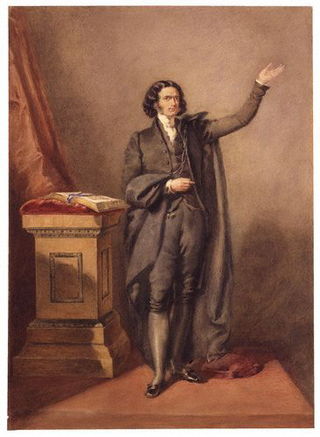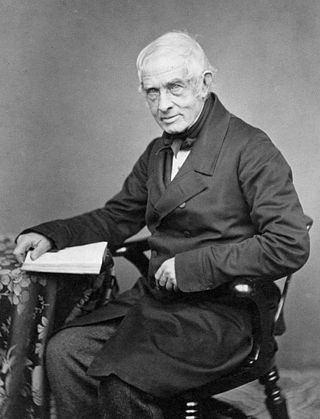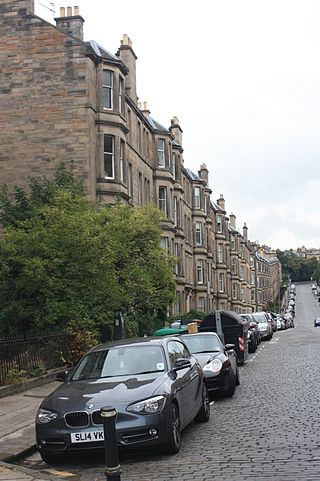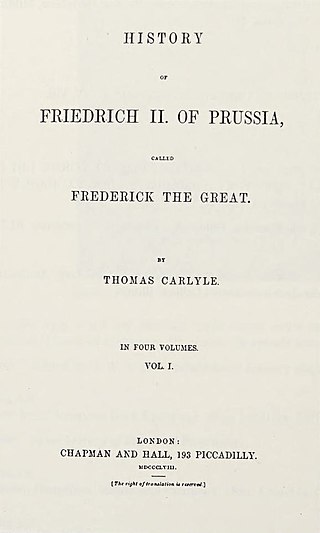
Sir Walter Scott, 1st Baronet, was a Scottish historian, novelist, poet, and playwright. Many of his works remain classics of European and Scottish literature, notably the novels Ivanhoe (1819), Rob Roy (1817), Waverley (1814), Old Mortality (1816), The Heart of Mid-Lothian (1818), and The Bride of Lammermoor (1819), along with the narrative poems Marmion (1808) and The Lady of the Lake (1810). He had a major impact on European and American literature.

Thomas Carlyle was a Scottish essayist, historian, and philosopher. A leading writer of the Victorian era, he exerted a profound influence on 19th-century art, literature, and philosophy.
Ecclefechan is a small village located in Dumfries and Galloway in the south of Scotland.

Edward Irving was a Scottish clergyman, generally regarded as the main figure behind the foundation of the Catholic Apostolic Church.

Henry Duncan FRSE was a Scottish minister, geologist and social reformer. The minister of Ruthwell in Dumfriesshire, he founded the world's first mutual savings bank that would eventually form part of the Trustee Savings Bank. He served as Moderator of the General Assembly of the Church of Scotland in 1839. At the Disruption has left the Church of Scotland and sided with the Free Church. He was also a publisher, a philanthropist and an author, writing novels as well as works of science and religion.

Carlyle's House, in Cheyne Row, Chelsea, central London, was the home of the Scottish essayist, historian and philosopher Thomas Carlyle and his wife Jane from 1834 until his death. The home of these writers was purchased by public subscription and placed in the care of the Carlyle's House Memorial Trust in 1895. They opened the house to the public and maintained it until 1936, when control of the property was assumed by the National Trust, inspired by co-founder Octavia Hill's earlier pledge of support for the house. It became a Grade II listed building in 1954 and is open to the public as a historic house museum.

Coldstream Bridge, linking Coldstream, Scottish Borders with Cornhill-on-Tweed, Northumberland, is an 18th-century Category A/Grade II* listed bridge between England and Scotland, across the River Tweed. The bridge carries the A697 road across the Tweed.

Thomas Faed RSA (1826–1900) was a Scottish painter who is said to have done for Scottish art what Robert Burns did for Scottish song.

John Crawfurd was a Scottish physician, colonial administrator, diplomat, and author who served as the second and last Resident of Singapore.

Craigenputtock is an estate in Scotland where Thomas Carlyle lived from 1828 to 1834. He wrote several of his early works there, including Sartor Resartus.

Thomas Carlyle was born in King's Grange near Dumfries in Scotland.

Comely Bank is an area of Edinburgh, the capital of Scotland. It lies southwest of Royal Botanic Garden and is situated between Stockbridge and Craigleith. It is bound on its northernmost point by Carrington Road and on its southernmost point by Learmonth Terrace. The area is covered by Stockbridge and Inverleith Community Council.

Reverend Dr John Lee FRSE was a Scottish academic and polymath, the Principal of the University of Edinburgh from 1840 to 1859. He was also a Moderator of the General Assembly of the Church of Scotland in 1844.

Jane Baillie Carlyle was a Scottish writer and the wife of Thomas Carlyle.

History of Friedrich II. of Prussia, Called Frederick the Great is a biography of Friedrich II of Prussia by Scottish essayist, historian and philosopher Thomas Carlyle. It was first published in six volumes from 1858 to 1865.

Critical and Miscellaneous Essays is the title of a collection of reprinted reviews and other magazine pieces by the Scottish essayist, historian and philosopher Thomas Carlyle. Along with Sartor Resartus and The French Revolution it was one of the books that made his name. Its subject matter ranges from literary criticism to biography, history and social commentary. These essays have been described as "Intriguing in their own right as specimens of graphic and original nonfiction prose…indispensable for understanding the development of Carlyle's mind and literary career", and the scholar Angus Ross has noted that the review-form displays in the highest degree Carlyle's "discursiveness, allusiveness, argumentativeness, and his sense of playing the prophet's part."
Events from the year 1826 in Scotland.

Thomas Brown was a Scottish architect in the early 19th century based in Edinburgh. He is best known for St. Mary's Church, Bellevue, Edinburgh, usually known as Bellevue Church.

Jean Thomson Harris was the wife of Paul Harris, a lawyer who founded the first Rotary Club in Chicago in 1905. She supported the organisation but was never allowed to join because she was a woman. She eventually joined the Inner Wheel and she was the first honorary member of the Inner Wheel Club of Edinburgh. Both her birthplace and burial site are commemorated with plaques. She is known internationally.

Scotsbrig is a farm near Ecclefechan, Dumfries and Galloway, Scotland, and a Category B listed building. Thomas Carlyle lived there with his family in the summer of 1826 before moving to 21 Comely Bank, Edinburgh. Scotsbrig remained a residence of the Carlyle family for decades. The farmhouse underwent numerous additions and renovations in the eighteenth and nineteenth centuries.



















